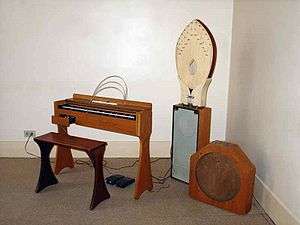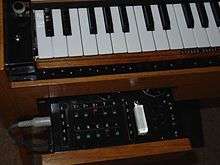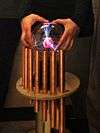Ondes Martenot
| Ondes Martenot | |
|---|---|
 An ondes Martenot (seventh generation model, 1975)[1] | |
| Dates | 1928-present |
| Technical specifications | |
| Polyphony | none[2] |
| Oscillator | vacuum tube |
| Synthesis type | heterodyne |
| Input/output | |
| Keyboard | 1 or 2 x 35 note manuals (G2–F5) |
The ondes Martenot (/ˈoʊnd mɑːrtᵻˈnoʊ/ or OHND mar-tə-NOH; French: [ɔ̃d maʁtəno], "Martenot waves"), also known as the ondium Martenot, Martenot and ondes musicales, is an early electronic musical instrument invented in 1928 by Maurice Martenot. The original design was similar in sound to the theremin.[3] The sonic capabilities of the instrument were later expanded by the addition of timbral controls and switchable loudspeakers.
The instrument's eerie wavering notes are produced by varying the frequency of oscillation in vacuum tubes. The production of the instrument stopped in 1988, but several conservatories in France still offer instruction to students of the instrument.[4]
In 1997 the Ondéa project began designing an instrument based on the ondes Martenot. Since the Martenot name is still protected, the new instrument is called Ondéa, but has the playing and operational characteristics of the original ondes Martenot. In 2001 a completed prototype was first used in concerts. These instruments have been in regular use since 2005.[5][6]
Since 2008 Jean-Loup Dierstein, with the support of Maurice Martenot's son, has been developing a new, officially named ondes Musicales instrument based on the model used when production stopped in 1988.[7]
In classical music
The ondes Martenot has been used by many composers, most notably Olivier Messiaen. He first used it in the Fête des Belles Eaux for six ondes, written for the 1937 International World's Fair in Paris[8] and then used it in several of his works, including the Turangalîla-Symphonie and Trois Petites Liturgies de la Présence Divine. His opera Saint-François d'Assise requires three of the instruments. The composer's widow, Yvonne Loriod-Messiaen arranged and edited four unpublished Feuillets inedits for ondes Martenot and piano which were published in 2001.[9] The ondes Martenot has also been used occasionally in transcriptions: Leopold Stokowski used the instrument in his ethereal orchestration of Buxtehude's Sarabande and Courante ("Auf meinen lieben Gott").
Other notable composers who have employed the ondes Martenot in their works include Charles Koechlin, Edgard Varèse (as a replacement for two theremin instruments in his work Ecuatorial), Arthur Honegger, Darius Milhaud, Cemal Reşit Rey, Maurice Jarre, Sylvano Bussotti, Giacinto Scelsi, Marcel Landowski, Karel Goeyvaerts, Pierre Boulez, Tristan Murail, Miklós Rózsa, Henri Tomasi, and Frank Zappa. André Jolivet wrote a prominent concerto for it in 1947.[10] Bohuslav Martinů authorized the adaptation of his Fantasie to the use of the ondes Martenot when it proved difficult to perform on the Theremin, for which it was originally written.[11]
Estimates of the number of works written for ondes Martenot vary. Hugh Davies reckoned there to be around a thousand works composed for the instrument, although Jeanne Loriod's figures are the more widely quoted: she estimated that there were 15 concertos and 300 pieces of chamber music.[12] Jacques Tchamkerten's provisional catalogue of works for ondes, included in the current reprinting of Loriod's Technique, lists far fewer works than either of these figures.[13]
In cinema and television
In 1936 Adolphe Borchard used it in Sacha Guitry's Le roman d'un tricheur, played by Martenot's sister, Ginette.[14] It was used by composer Brian Easdale in the ballet music for The Red Shoes.[15] It was frequently used in horror and science fiction movies and television, notably in the 1950s.
In 1962 French composer Maurice Jarre introduced the ondes Martenot to American cinema in his score for Lawrence of Arabia.[16] Later, the English composer Richard Rodney Bennett used it for such diverse scores as Billion Dollar Brain (1967) and Secret Ceremony (1968).[17] It was through him that Elmer Bernstein first learned about the instrument, and later used it in several films, among them Heavy Metal,[18] Ghostbusters,[19][20] The Black Cauldron,[20] and My Left Foot.[20] Other film scores using the ondes Martenot include There Will Be Blood (2007) by Jonny Greenwood and Hugo (2011) by Howard Shore.[21]
Barry Gray used Ondes Martenot for his film and television soundtracks of the 1950s and 1960s. David Fanshawe incorporated the ondes into his main theme and score for the Yorkshire Television series Flambards (1979).
The musical instrument is the subject of the 2013 Quebec documentary Wavemakers.[22]
In popular music

One of the first integrations of the ondes Martenot into popular music was done in French chanson during the fifties and sixties. For example in some of Baudelaire's poems set to music by French singer Léo Ferré in his albums Les Fleurs du mal (1957)[24] and Léo Ferré chante Baudelaire (1967), or in popular dramatic lovesong Jacques Brel's "Ne me quitte pas" (1959).[25] During the seventies Beau Dommage and Harmonium, the two most popular musical groups of the Quebec musical scene, made extensive use of this instrument (introduced there by Marie Bernard) in each of their 1975 albums, respectively Où est passée la noce?[26] and Si on avait besoin d'une cinquième saison.[27] Harmonium later toured with Supertramp[28]
Jonny Greenwood is often credited with bringing the ondes to a larger audience through Radiohead's Kid A (2000), Amnesiac (2001), Hail to the Thief (2003),[29] In Rainbows (2007), The King of Limbs (2011) and A Moon Shaped Pool (2016) albums. Greenwood uses the ondes Martenot often in his compositions, and has written a piece for the instrument, entitled Smear.[30][31] In live concerts, Radiohead have used six ondes for "How to Disappear Completely"[32] and for "Weird Fishes/Arpeggi".[33]
The ondes Martenot was also utilized by Bryan Ferry, in 1999, on the album As Time Goes By,[34] and by Joe Jackson on his 1988 soundtrack album for Tucker: The Man and His Dream[35] and his 1994 album Night Music.[36] Recently, ondist Thomas Bloch has toured[37] in Tom Waits and Robert Wilson's show "The Black Rider" with Marianne Faithfull (2004–06)[38] and in Gorillaz leader Damon Albarn's show "Monkey: Journey to the West" (2007 onward).[39]
Also Yann Tiersen, well known for writing the music to the film Amélie, often features the use of the ondes Martenot in his music, with Christine Ott. His DVD La Traversee, documenting the recording of Les Retrouvailles, shows his use of the instrument.[40]
In 2009, bruit direct disques[41] released a 12" 45rpm vinyl record of original ondes martenot compositions by Accident du travail.[42]
In their 2013 album Random Access Memories, Daft Punk used the ondes Martenot on Track #7 - "Touch" featuring Paul Williams. It was played by Thomas Bloch.
In 2009 & 2016, Christine Ott released two solo albums in which there's modern-classical compositions with Ondes Martenot. Solitude Nomade & Only Silence Remains on Gizeh records.[43]
Playing technique


The ondes Martenot is unique among electronic musical instruments in its methods of control.[44] Maurice Martenot was a cellist, and it was his vision to bring the degree of musical expressivity associated with the cello to his new instrument.[45] The ondes, in its later forms, can be controlled either by depressing keys on the six-octave keyboard (au clavier), or by sliding a metal ring worn on the right-hand index finger in front of the keyboard (au ruban). The position of the ring corresponds in pitch to the horizontal location along the keyboard. The latter playing method allows for unbroken, sweeping glissandi to be produced in much the same manner as a Theremin. The keyboard itself has a lateral range of movement of several millimeters, permitting vibrato of nearly a semitone below or above the pitch of the depressed key to be produced.
By depressing keys or moving the ring, no sound is initially produced. A control operated by the left hand and situated in a small drawer of controls (tiroir) on the left side of the instrument controls the musical dynamics, from silence to fortissimo. This control (touche d’intensité) is glass and lozenge-shaped, and can be depressed several centimetres. The depth to which this key is depressed determines the dynamic level: the deeper, the louder. The manner in which it is pressed determines the attack of the note: quick taps produce staccato articulations, whilst more controlled and deliberate depressions are used to play legato.
The small drawer of controls also contains flip-switches to control the instrument's timbre. These function in much the same way as a pipe organ's stops can be added or removed. Like organ stops, each switch has its own sound color, which can be added to the chorus of other timbres. The 1975-model instrument features the following timbres:
| Onde (O) | A simple sine wave timbre. Similar in sound to the flute or ocarina. |
| Creux (C) | A peak-limited triangle wave. Similar in sound to a clarinet in high registers. |
| Gambe (G) | A timbre somewhat resembling a square wave. Intended to be similar in sound to string instruments, as the French title would suggest. |
| Petit gambe (g) | A similar but less harmonically-rich timbre than Gambe. The player can control the intensity in the signal by using a slider situated in the control drawer. |
| Nasillard (N) | A timbre resembling a pulse wave. Similar in sound to a bassoon in low registers. |
| Octaviant (8) | A timbre with a reinforced second harmonic produced by full-wave rectification. The intensity in the signal can be controlled by using a slider. This setting is analogous to the 4 foot stop in organ terminology. |
| Souffle (S) | A timbre often described as white noise, but in fact pink noise of indefinite pitch. |
In addition to the timbral controls, the control drawer also contains flip switches that determine to which loudspeakers (diffuseurs) the instrument's output are routed. These are labeled D1 to D4.

- D3: Métallique,
- D4: Palme,
- D1: Principal with
D2: Résonance
| D1 Principal |
A traditional, large loudspeaker. |
| D2 Résonance |
A loudspeaker that uses springs to produce a mechanical reverb effect. |
| D3 Métallique |
A small gong is used as the loudspeaker diaphragm to produce a 'halo' effect rich in harmonics. |
| D4 Palme |
An iconically lyre-shaped loudspeaker, using strings to produce sympathetic resonances. |
See also
- The Electro-Theremin similarly uses a slider to control an oscillator's pitch, and is famous for being used in the song "Good Vibrations" by the Beach Boys.
- The Ondioline, a French electronic musical instrument invented and manufactured by Georges Jenny in the 1940s, used a similar keyboard to the Ondes, but was capable of much more variety in its sounds. It was marketed as a less expensive alternative to the Ondes Martenot.
- The Therevox uses the au ruban and touche d’intensité of the Ondes Martenot as part of a dual oscillator analog synthesizer.
- Jeanne Loriod's three-volume Technique de l'onde electronique, type Martenot (Leduc, 1987) is considered to be the standard reference work on the ondes Martenot. It has a preface written by Olivier Messiaen.
Players
References
- ↑ "Ondes Martenot - Thomas Bloch".
- ↑ Sibyl Marcuse, "Ondes Martenot", Musical Instruments: A Comprehensive Dictionary, corrected edition (New York: W. W. Norton 7 Company, Inc., 1975): 377.
- ↑ K.D. Skeldon, L.M. Reid, V. McInally, B. Dougan, C. Fulton: "Physics of the Theremin", American Journal of Physics 66 (1998) 11:945–55.
- ↑ Thomas Bloch, insert notes to Naxos Records CD 8.555779 "Music for ondes Martenot", p. 9
- ↑ Timeline of the Ondéa replica development.
- ↑ Extensive (21 pages) documentation on the Ondéa (Ondes Martenot replica) (in French).
- ↑ "Ondes Martenot" on Thomasbloch.net
- ↑ Hill, Peter; Simeone, Nigel (2005). Messiaen. Yale. pp. 74–75. ISBN 978-0-300-10907-8.
- ↑ Bloch, p. 7.
- ↑ Hilda Jolivet: Avec André Jolivet (Flammarion, 1978), pp. 188–90
- ↑ Bloch, p. 8
- ↑ Both are cited in Douglas Martin, "Jeanne Loriod, Who Transformed Electronic Wails Into Heartfelt Music, Dies at 73", New York Times (19 August 2001).
- ↑ Jacques Tchamkerten: catalogue of works for ondes Martenot in Jeanne Loriod: Technique de l'onde electronique type Martenot, vol. 2 (Leduc)
- ↑ entry at imdb.com
- ↑ Brian Easdale at the Proms
- ↑ Mervyn Cooke (2008). A History of Film Music. Cambridge and New York: Cambridge University Press. p. 333.
- ↑ Ross Care and Lukas Kendall, "FSM Online Liner Notes" Film Score Monthly (n.d.).
- ↑ Interview with Dan Goldwasser, originally published on SoundtrackNet, July 2000
- ↑ Interview with Randall D. Larson, originally published in CinemaScore #13/14, 1985
- 1 2 3 Bernstein biography from official site
- ↑ Howard Shore, Hugo - Original Score, CD booklet, published by Paramount Pictures in the year 2011
- ↑ Dunlevy, T'cha (13 March 2013). "Review: Le chant des Ondes". Montreal Gazette. Retrieved 28 November 2014.
- ↑ Ondes Martenot, The King of Gear, 2013
- ↑ Léo Ferré (10 Apr 2008) [reissue from 1957 album], Les Fleurs Du Mal (CD, Album, Remastered), La Mémoire Et La Mer, 19 956,
Track 3. Les Hiboux, 10. La Vie Antérieure, 11. La Pipe'
- ↑ Jacques Brel (Nov 1959), N° 4 (Vinyl, Album), Philips, B 76.483 R,
Track A5. Ne Me Quitte Pas -- Music By [Uncredited] - Gérard Jouannest, Ondes Martenot [Uncredited] - Sylvette Allart
- ↑ Beau Dommage (1975), Où Est Passée La Noce? (Vinyl, Album), Capitol Records / EMI, SKAO 70.037,
Track B1. En Pleine Face -- ... Ondes Martenot - Marie Bernard ...
- ↑ Harmonium (1975), Les Cinq Saisons (Vinyl, Album), Celebration, CEL-1900,
Track B: Un Incident À Bois-Des-Filions -- ... Ondes Martenot - Marie Bertrand, ..."
- ↑ "Harmonium", ProgQuébec - Le Retour du Rock Québécois/The Return of Quebec Rock
- ↑ Radiohead (10 Jun 2003), Hail To The Thief (CD, Album), Capitol Records, CDP 7243 5 84543 2 1,
Credits: Electronics [Ondes Martenot] - Jonny Greenwood
- ↑ Jonny Greenwood's "smear" to Receive US Premiere at New York's SONiC Festival, Nonesuch Records, October 17, 2011,
Greenwood's smear is scored for large ensemble and two ondes martenots, early electronic instruments that Greenwood often uses with Radiohead. ...
- ↑ Adriaan Pels (March 11, 2004), "Newspaper reviews of Jonny Greenwood's 'Smear'", Radiohead News, Radiohead At Ease
- ↑ video of "How to Disappear Completely", with 6 Ondes
- ↑
- ↑ Bryan Ferry (1999), As Time Goes By (CD, Album), Virgin, DGVIR89,
Credits: Ondes Martenot - Cynthia Millar
- ↑ Joe Jackson (1988), Tucker: The Man And His Dream (Original Motion Picture Soundtrack) (Vinyl, LP, Album), A&M Records, SP-3917,
Credits: Ondes Martenot - Arlette Fibon
- ↑ Joe Jackson (1988), Night Music (CD, Album), Virgin Records America, 7243 8 39880 2 0,
Credits: Ondes Martenot - Jean Laurendeau (tracks: 1,10)
- ↑ "Thomas Block - Biography", ThomasBloch.net
- ↑ Robert Simonson (2004-09-09), Tom Waits' Black Rider Extends Again at ACT, Playbill.com,
The score of The Black Rider calls for an eclectic pit of such instruments as the toy piano, the pocket trumpet, the Stroh violin, the Ondes Martenot, the glass harmonica, the Cristal Baschet, the drunk piano and the musical saw.
- ↑ Ivan Hewett (23 Jun 2007), "A whole new aria for Damon", The Daily Telegraph,
He shows me some of the instruments in the ensemble: there's a glass harmonica, which looks like a giant ribbed glass vase tipped on one side, and an ondes Martenot, the tremulous 1920s electronic instrument. ...
- ↑ Yann Tiersen (23 May 2005), Les Retrouvailles (CD, Album, DVD (limited edition)), , 0946 3114650 3,
Track CD.11. La Boulange -- Drums - Ludovic Morillon, Ondes Martenot - Christine Ott. ... DVD.2.6: "La Boulange"
- ↑ bruit direct disques, record label website
- ↑ myspace for accident du travail, julie normal and olivier 2mo
- ↑ Christine Ott (20 May 2016), Only Silence Remains (CD, Vinyle), Gizeh Records, GZH66,
Only Silence Remains is an album of great variety, from modern-classic to experimental music. Ott's approach on this album creates a space where the piano and Ondes Martenot are the focal point, and accompanied by harmonium, tubular bells, percussions and vintage keyboards. Ondes Martenot especially on Sexy Moon, Danse avec la Neige, Tempête & A mes étoiles
- ↑ Loriod, 1987
- ↑ Jean Laurendeau: Maurice Martenot: Luthier de l'Electronique (Dervy Livres, 1996)
Further reading
- Orton, Richard, and Hugh Davies. "Ondes martenot". The New Grove Dictionary of Music and Musicians, second edition, edited by Stanley Sadie and John Tyrrell. London: Macmillan Publishers.
External links
- About Ondes Martenot (English)
- Sculpting music with the ondes martenot - Radio France Internationale (English)
- Ondes Martenot : facts, videos, pictures, discography, works... (English)
- Présentation détaillée des Ondes Martenot (French)
- Christine Ott ; movie soundtracks, "ciné concerts", discography, videos, works...
- The presentation of Ondes Martenot C° Federation des Enseignements Martenot (English)
- Audities Foundation Model 6 Ondes Martenot
- BBC Radio 6 Music - The Great Bleep Forward
- A virtual Ondes Martenot produced by software company Soniccouture
- Selected repertoire, photography, sound installations and extracts with ondes, Nathalie Forget
- Technical overview of the Ondes Martenot, by Ondes performer Estelle Lemire
- The Ondes Martenot on '120 years Of Electronic Music'
- Palme et onde martenot DIY
- François Evans demonstrating sections of a model 6 Ondes Martenot at Synthtopia website
